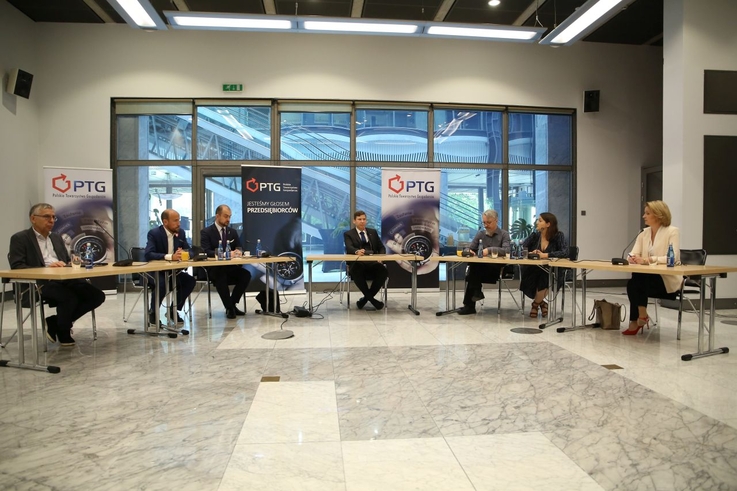Umowa pomiędzy Łukasiewicz – Instytutem Lotnictwa a GE Power
8 marca 2023 roku w Warszawie doszło do podpisania umowy pomiędzy Łukasiewicz – Instytutem Lotnictwa a GE Power. Umowa ta ma na celu wsparcie współpracy pomiędzy obydwoma firmami w ramach budowania przyszłościowych rozwiązań oraz rozwijania usług serwisowych dla branży energetycznej.
- Budowa przyszłościowych rozwiązań
- Rozwój usług serwisowych dla branży energetycznej
- Współpraca na zasadach partnerskich
Umowa obowiązuje do końca roku 2035, dzięki czemu Łukasiewicz – Instytut Lotnictwa i GE Power mają wystarczająco czasu na wykonanie wszystkich zadanych zadań i celów.
Jesteśmy przekonani, że współpraca ta przyniesie wiele korzyści dla obu firm oraz klientów. Poprzez wzajemne wsparcie obu stron będziemy w stanie osiągnąć przełomowe technologie, które pozwolą na dalszy rozwój obu firm.
Growth in Key Markets
We remain focused on growth in key markets, including Europe, India, and China. This growth helps us achieve sustainable profitability as the demand for clean, affordable, low emissions transportation solutions grows.
Innovation and Technology Development
Innovation and technology development is a cornerstone of our business. We plan to build on our success in 2022 by introducing and educating our customers and the market about our H2 HPDI™ solution. In addition, we will continue to work directly with key OEMs to advance the evaluation of our solution for long-haul, heavy-duty transport.
At Westport, we are proud to be part of the solution with products that are accelerating the reduction of GHG emissions. Our commitment to reducing emissions and driving sustainability into the transportation industry will continue to be a priority in the coming years.
Impact on Revenues
The weakening of the Euro against the U.S. dollar had a negative impact on our full year revenues. The full year impact of the acquisition of our fuel storage business in June 2021, increased sales volume of our hydrogen and electronics products, higher delayed-OEM volumes and increased sales volumes to OEMs in India of our light-duty OEM products contributed to the growth in revenues. These positive impacts were negatively impacted by the fuel price volatility, lower sales volume to Russian customers in the independent aftermarket and OEM businesses from the ongoing Russian-Ukraine conflict, and lower sales of CNG and LNG products due to higher natural gas prices in the European market.
Impact on Net Loss
Net loss for the fourth quarter in 2022 was $(16.9) million, or $(0.10) per share, compared to net income of $5.4 million, or $0.04 per share, for the same period in 2021. Net loss for the year ended December 31, 2022 was $(32.7) million, or $(0.19) per share, compared to net income of $13.7 million for the prior year. The net loss was primarily attributed to:
- Lower gross margins as a result of a combination of the foreign exchange rate and increasing material, manufacturing and labour costs.
- Loss of equity income from the termination and sale of the Cummins Westport Inc. („CWI”) joint venture.
The impacts of foreign exchange rate and increasing material, manufacturing and labour costs have presented a challenge to the company, however, we remain committed to staying at the forefront of innovation, and continuing to provide the highest quality products and services to our customers.
Conclusion
This past year has been a difficult one for the business, but the resilience of the organization has enabled us to remain profitable despite the challenges. We are committed to continued improvement and believe that our focus on innovation and customer satisfaction will lead to sustainable growth in the years to come.
Key Takeaways
- OEM revenue decreased due to the decrease in average Euro rate versus the U.S. dollar and a decrease in sales for our light-duty OEM business.
- Heavy-duty OEM sales volumes decreased due to the unfavorable fuel price differential between LNG and diesel in Europe.
- We remain committed to continued improvement and believe that our focus on innovation and customer satisfaction will lead to sustainable growth in the years to come.
We are optimistic about the future and will strive to build on the progress achieved this year in order to create even more value for our customers, shareholders, and other stakeholders.
Key Drivers
- Increased sales volumes to OEMs in India of our light-duty CNG products
- Increased sales volumes of our electronics, fuel storage, hydrogen and delayed-OEM products
- Lower sales volumes in Western Europe for our light-duty OEM products
- Lower year-over-year revenues in our heavy-duty OEM business
- Foreign exchange impact from the strengthening of US dollar against the Euro
Overall, our financial performance for the full year 2022 was in line with our expectations and the OEM segment represented the majority of our total revenue. We remain confident in our ability to continue to meet our customer needs and drive increased revenue for the years to come.
We have implemented a number of initiatives to ensure we remain competitive in the global marketplace and have seen a positive response from our customers. Going forward, we are committed to investing in our business to ensure we continue to provide our customers with the best products and services.
Revenue Trends
The company expects continued revenue growth in the coming year, driven by increased sales volumes in the Russian market, improved market conditions in Turkey and Argentina, and the continued strength of the US dollar.
Costs
The company is also expecting to incur additional operating costs, as they will be investing in new technology to increase efficiency and respond to the changing market conditions.
- Investment in new technology
- Increased sales and marketing efforts
- Expansion into new markets
The company is committed to remaining agile and responsive to changing market conditions and the ever-evolving digital landscape. By staying ahead of the curve, they will be in a strong position to capitalize on emerging opportunities and drive continued success in the years to come.
The company is confident that their investment in new technology and diversified product offerings will help them maintain their competitive edge and generate long-term value for their customers and shareholders.
Our 2023 Goals
- Improving Top Line Revenue: Secure additional customer supply agreements and expand volume throughout the business.
- Cost Structure: Put in place a slate of efficiency improvements and optimize various business units.
- Liquidity Management: Remain prudent in our liquidity management and focus capital expenditure on hydrogen and test cell capacity.
- Innovation: Continue to develop technology for the future to stay ahead of the competition.
We are confident that our team has the knowledge and capabilities to successfully execute on our plans for 2023. Our company mission is to provide clean, affordable transportation solutions and ensure a prosperous future for our customers, employees, and shareholders.
We recognize that success will require us to commit to changing the way we operate, thinking differently and challenging the status quo. We are excited to take on the challenge and look forward to the year ahead.
We are confident in our ability to build a better future for Westport, and to remain a leader in the clean transportation industry.
Westport’s financial statements and Management’s Discussion and Analysis for the year ended December 31, 2022 are available on the Company’s website at www.westport.com and on SEDAR at www.sedar.com.
Conclusion
We are confident that Westport is well-positioned to capitalize on the transition to alternative fuel sources and will continue to be a leading innovator in the field. We are committed to providing clean, affordable and reliable solutions that will drive long-term value for our customers and shareholders.
We are also excited to explore potential partnerships and collaborations with governments, industry, and other organizations to further develop and commercialize our products and solutions.
Westport Fuel Systems is a leading global supplier of engines, fuel systems, and other technologies for the transportation industry.
Westport Fuel Systems is focused on delivering leading global transportation solutions that are designed to reduce emissions, increase fuel efficiency, and lower overall operation costs. We are a leader in the development of advanced natural gas, propane autogas, and hydrogen fuel systems for a variety of transportation applications.
Our key technologies are:
- Advanced Natural Gas Engines
- Propane Autogas Fuel Systems
- Hydrogen Fuel Systems
Westport Fuel Systems is committed to providing the highest quality products and services to our customers, while maintaining our commitment to the environment and sustainability.
We are dedicated to providing our customers with the best possible solutions to their transportation needs, and to delivering on our promise of superior customer service and support.
We are excited to continue to innovate and develop new technologies for the transportation industry and look forward to continuing to be a leader in the global transportation industry.
At Westport Fuel Systems, we are dedicated to providing the best possible solutions for our customers and the global transportation industry. We are committed to reducing emissions, increasing fuel efficiency and providing superior customer service and support. As we continue to innovate and develop new technologies, we strive to remain a leader in the global transportation industry.
This document contains forward-looking statements about Westport Fuel Systems’ future plans and intentions, outlook, business prospects, anticipated financial results, and the effects of new accounting standards. These statements may generally, but not always, be identified by the use of words like “will”, “expect”, “believe”, “estimate”, “anticipate”, “intend”, “plan”, “forecast” and similar expressions. All forward-looking statements reflect Westport Fuel Systems’ beliefs and assumptions based on information available at the time the statements were made. Actual results or events may differ from those predicted in these forward-looking statements. Factors that could cause actual results or events to differ materially from current expectations include, but are not limited to, the risk factors and other disclosures about the company and its business included in Westport Fuel Systems’ periodic filings with securities regulatory authorities.
Innovation to Power a Cleaner Tomorrow
At Westport Fuel Systems, we are dedicated to achieving our mission of powering a cleaner tomorrow through innovation. Our product portfolio is comprised of advanced fuel delivery components and systems for clean, low-carbon fuels such as natural gas, renewable natural gas, propane, and hydrogen. Our products have been designed to meet the performance and fuel efficiency requirements of transportation applications, while also providing environmental benefits that address climate change and urban air quality challenges.
We are proud to serve our customers in more than 70 countries, with leading global transportation brands. We continually strive to anticipate and exceed our customer’s needs by continuously innovating and improving our products and services.
Our Commitment to Sustainability
At Westport Fuel Systems, we believe that sustainability is an important part of our business. We are committed to reducing our environmental impact and contributing to a more sustainable future. To achieve this, we follow a comprehensive sustainability strategy that focuses on:
- Reducing emissions from our products and operations
- Encouraging responsible resource use
- Promoting health and safety
- Engaging with our stakeholders
We are committed to ongoing improvements in sustainability and strive to be a leader in the industry. We are dedicated to working with our partners and customers to build a cleaner, healthier, and more sustainable future.
At Westport Fuel Systems, we believe that innovation and sustainability go hand in hand. We are committed to investing in technology, people, and products that will drive a cleaner future. The future is full of possibilities and we look forward to continuing to innovate and power a cleaner tomorrow.
Generally Accepted Accounting Principles (GAAP) provide a set of rules and guidelines for the preparation of financial statements. Companies use GAAP to ensure their financial statements are accurate and comparable. GAAP can also help investors and other users of financial information analyze and compare companies.
In addition to GAAP measures, many companies also report non-GAAP financial measures. Non-GAAP measures are financial measures that are not in accordance with GAAP, but are intended to provide investors with additional information about a company’s performance. While non-GAAP measures can be useful, it is important to understand their limitations and how they are used by companies.
What Are Non-GAAP Financial Measures?
Non-GAAP financial measures are measures that are not in accordance with GAAP but are instead designed to provide investors with additional insight into a company’s financial performance. Examples of non-GAAP measures include:
- Adjusted Operating Income
- Adjusted Earnings Per Share
- Adjusted Free Cash Flow
- Adjusted Return on Equity
Non-GAAP measures are often used to give investors a better understanding of a company’s underlying performance, by excluding items that are not part of the company’s core operations. For example, a company may exclude the impact of non-recurring items such as restructuring costs, asset impairments, or one-time legal costs from its non-GAAP financial measures.
Limitations of Non-GAAP Measures
While non-GAAP measures can be useful, it is important to understand their limitations. Non-GAAP measures are not in accordance with GAAP and may not provide a complete picture of a company’s performance. In addition, non-GAAP measures may not be comparable to similar measures used by other companies.
It is important to carefully review and understand a company’s non-GAAP measures before using them to assess a company’s performance. It is also important to review the company’s GAAP financials to ensure that the non-GAAP measures provide a complete and accurate picture of the company’s performance.
Non-GAAP financial measures can be a useful tool for investors to gain additional insight into a company’s performance, but it is important to understand their limitations and use them with caution. It is always best to use both GAAP and non-GAAP measures to assess a company’s performance.
In conclusion, while non-GAAP measures can provide investors with additional insight, it is important to understand their limitations and use them with caution. Investors should always use both GAAP and non-GAAP measures to assess a company’s performance and make informed investment decisions.
EBITDA and Adjusted EBITDA – An Overview
EBITDA and Adjusted EBITDA are non-standardized metrics used to measure a company’s financial performance. They are intended to provide investors and analysts with additional information to better understand a company’s financial performance before interest, taxes, depreciation and amortization. The metrics are commonly used to compare companies within the same industry.
EBITDA and Adjusted EBITDA exclude the impact of cash costs of financing activities and taxes, and the effects of changes in operating working capital balances. The following are some of the key points to consider when using EBITDA and Adjusted EBITDA:
- EBITDA focuses on a company’s operating performance and is calculated as net income plus interest, taxes, depreciation and amortization.
- Adjusted EBITDA is a more comprehensive measure of a company’s financial performance and is calculated as net income plus interest, taxes, depreciation, amortization, stock-based compensation and other non-cash expenses.
- Both EBITDA and Adjusted EBITDA are not necessarily indicative of operating profit or cash flow from operations as determined under U.S. GAAP.
- EBITDA and Adjusted EBITDA should not be considered in isolation or as a substitute for measures of performance prepared in accordance with U.S. GAAP.
It is important to remember that companies may calculate EBITDA and Adjusted EBITDA differently, so it is important to understand the exact methodology used in order to make a more accurate comparison between companies.
In conclusion, EBITDA and Adjusted EBITDA are useful metrics to have in one’s toolbox when evaluating a company’s financial performance. However, it is important to consider the limitations of these metrics and to understand the exact methodology used for calculation in order to make a more accurate comparison between companies.
Źródło dystrybucji: pap-mediaroom.pl






